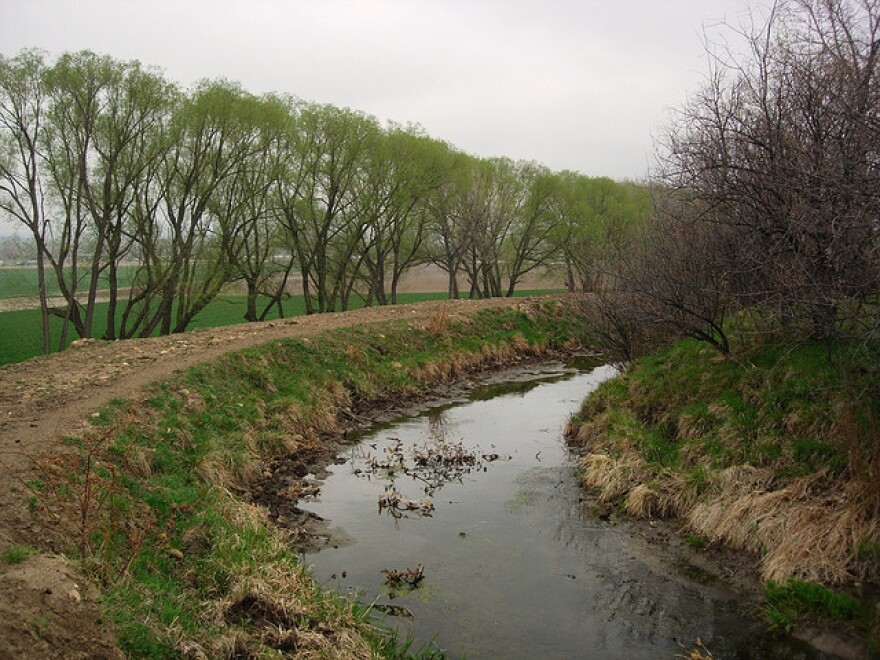Afternoon clouds and occasional rains have dotted the Western Slope in the past few weeks, but that doesn’t mean people aren’t still worried about their water.
Last week Matthew Harris posted on the Almanac that the water he gets from German Creek was called on by a senior rights holder for the first time in the eight years he’s lived in Paonia. His creek’s just one of many that snake across the North Fork Valley, but if it’s been that long since that senior rights holder felt like they needed more water, should other residents and farmers be concerned?
"Sometimes Colorado just goes through dry cycles," says Wendy Ryan, the Assistant State Climatologist at Colorado State University. She says this year’s snowpack levels were about a fourth lower than average, and last year’s were even worse.
"So not having that water available to recharge soils really brought down base flows during the winter time last year, " Ryan says. "Last year’s dryness coupled with last year’s really hot temperatures really put a strain on a lot of systems in Colorado.
Ryan says this year initially didn’t look any better.
"Watching snowpack numbers come in again this year, everyone was kind of on edge. The northern mountains, the South Platte, and the upper Colorado basin really benefited from spring storms that the Gunnison Basin, the San Juan Mountains really didn't pick up," she says. "It’s really just that persistent dryness for this long that's started taxing some water systems in the state."
All the same, strains on water supplies over the past two years aren’t necessarily unusual given the state’s history of variability. Ryan notes that it’s maybe pure speculation, but her guess is that if Matthew Harris lived in Paonia in 2002, his water rights would've been curtailed then as well.
As for now, things are actually starting to look better across the state:
"You’re now seeing the monsoon kick up, which is awesome news. It’s good to see that moisture stream come back into Colorado, getting some of these soil profiles wet is less demand on reservoir water," she says, "and it’s a critical time for crops across the state."
Farmers and residents might be happy to learn this year’s water situation isn’t as bad as last year’s, mainly because it hasn’t been as hot.
"We haven't been quite as warm this year. In July we've ramped up some moisture, we've knocked those temperatures down," Ryan explains. "I don't know that they're going to come out too much below average for July, but we're not setting extremes like we did last year."
But what about the longer-term water situation? Are the past two years really just a fluke?
A recent study put out by researchers at Colorado State and Boston University says that across much of the country, more rain and snow are falling during wet cycles, and dry spells are actually getting shorter.
On the Almanac, Angela Davis noticed this trend from Florida, where she said so much rain has been falling lately that it’s actually starting to frustrate some farmers. So if the country as a whole is getting more rain, why isn’t it dropping on Colorado?
"The eastern U.S. is dominated by different weather patterns than we are," says Ryan. "There's a pretty active hurricane season this year, so they've been getting a lot of moisture off the Atlantic."
Rain and snow in Colorado depends on moisture pulled in from the Pacific and up over the mountains. Although weather patterns in Colorado can change drastically from year to year, Ryan admits the past couple years are unusual. However, she says there’s still hope that Colorado will pull out of drought conditions soon.
"We don't normally have dry conditions across the entire state," says Ryan. She says this month's moisture has been reassuring, and explains that even one good snowpack year can refill reservoirs and ease water concerns across the state. "Things can change quickly, they could also change very slowly," Ryan says. "But we're hoping that the pattern that we're in now will persist and dig us out of this drought that we're in."




